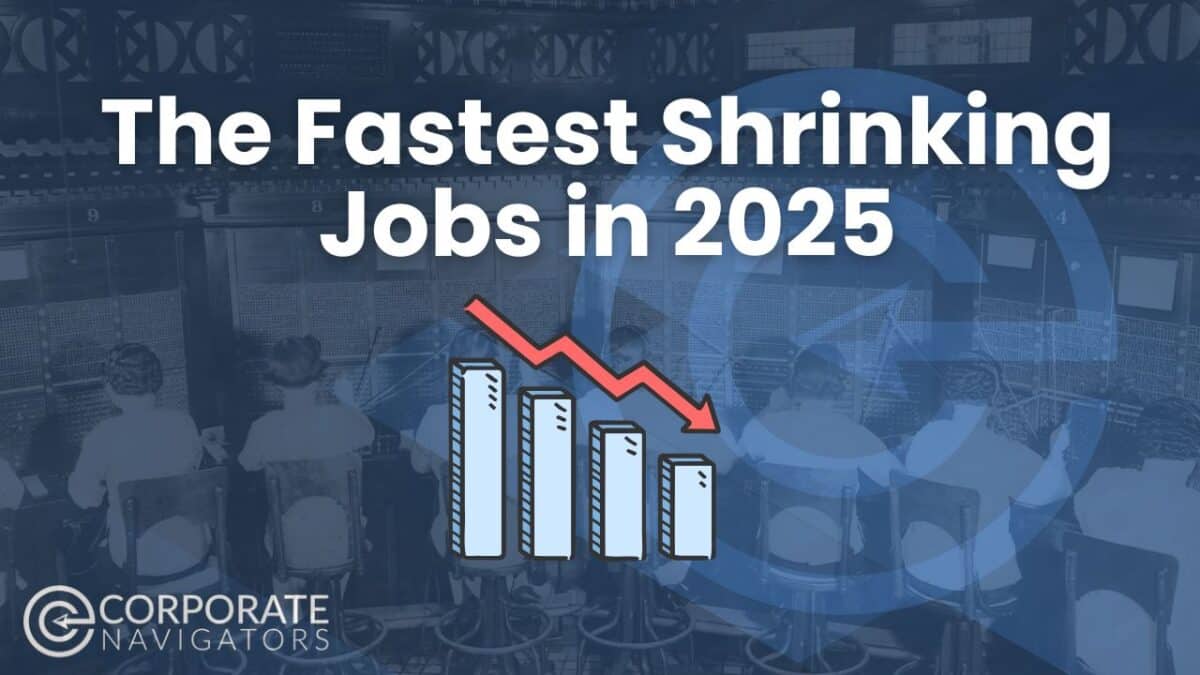
Table of Contents: Fastest Shrinking Jobs
The Fastest Shrinking Jobs in America in 2025
Times are always changing whether we like it or not, making once in-demand jobs fall out of popularity. Just like telephone operators used to be widely essential and are now rare, technology and other advancements continually alter what fields are growing and what are in decline.
Based on the latest data from the U.S. Bureau of Labor Statistics and related analyses, here are the top 10 fastest-shrinking jobs projected between 2023 and 2033. We will also give some explanations on what each job entails and the reasons behind their decline. Knowing what’s happening in today’s job market can help workers and employers plan for the future.
The Top 10 Shrinking Jobs in America in 2025
1. Word Processors and Typists
These professionals type and format documents, often handling clerical tasks like transcription and preparation of written materials. But with the rise of handy AI tools like Google Gemini taking notes during virtual meetings and other innovations related to this field, the role of the typist is declining sharply and expected to shrink by 38% in the next few years. As we continue to see advances in voice recognition software, automation, and general office digitization, manual typing and transcription will become increasingly obsolete.
2 Roof Bolters, Mining
A roof bolter in the mining industry operates machinery to secure the roofs in underground mines in order to protect miners. This job has declined by 32% due to a reduced demand for coal and other mined materials and an increased use of automated mining technology. These two factors reduce the need for manual labor in hazardous environments.
3. Telephone Operators
If you turn on an old movie from the golden era of cinema, you’ll notice the characters asking the operator to connect them in many instances. Not too long ago, the telephone operator would manage call routing and connections for telephone systems, acting as human intermediaries in communication networks. However, today’s automation, computerized switching systems, and mobile communication technologies continue to replace these roles, causing a projected decline of 26.4%.
4. Switchboard Operators, Including Answering Service
Not to be confused with telephone operators, switchboard operators connect calls and provide answering services with a manual or computerized switchboard system, physically connecting incoming calls to the correct person or department within an organization. The growth of automated phone systems and AI-driven call-management software reduces the need for manual operators, with employment in this field projected to drop by 25.2%.
5. Data Entry Keyers
Data entry clerks input information into computer systems from various sources. This job requires peak concentration and attention to detail, since the typical tasks include typing information from various sources such as checks, reports, invoices, or customer records into digital formats, maintaining and organizing this data to ensure it is accurate and easily accessible.
Data entry clerks also compare source documents with entered data to identify and correct errors and report any anomalies to supervisors to ensure data integrity. These jobs are declining by 25% because automation, optical character recognition (OCR), and AI software are increasingly performing these tasks more quickly and accurately than humans.
6. Foundry Mold and Coremakers
Foundry mold and coremakers create molds and cores used in metal casting manufacturing. These skilled workers are highly detail-oriented, often operating molding-related machinery and using tools to shape and finish molds. Today, the role is shrinking as automation and modern technology reduce the need for manual mold-making. Specifically, it’s shrinking by 24.6% as manufacturing processes evolve with automation and 3D printing, reducing reliance on traditional mold-making skills.
7. Loading and Moving Machine Operators, Underground Mining
Here is another job related to mining taking a hit. These operators control machinery involved in transporting materials underground. The projected 22.9% decline reflects the shrinking mining industry and increased mechanization and automation.
8. Patternmakers, Metal and Plastic
Patternmakers are highly skilled craftspeople who build patterns for casting metal and plastic parts. They create precise patterns, templates, and core boxes used primarily in foundries for metal and plastic casting processes. These patterns serve as models or molds for manufacturing metal or plastic parts by shaping molten material into the required forms.
They lay out, machine, fit, and assemble castings and parts to metal or plastic foundry patterns, core boxes, or match plates. Unfortunately, technological advances, including computer-aided design (CAD) and automated manufacturing, contribute to a 22.2% employment drop in this occupation.
9. Telemarketers
Telemarketers contact potential customers to sell products or services, engaging with customers in real time. The rise of automated calling systems, online marketing, and consumer resistance to cold calls have reduced this job’s demand significantly… by 21.5% to be exact.
10. Engine and Other Machine Assemblers
Engine and other machine assemblers work primarily in manufacturing industries such as automotive, aerospace, and industrial machinery production, where they put together engines, transmissions, and other mechanical components.
These jobs are projected to decline by 21.3% due to the growing use of automation and robotic assembly lines, which can perform the work more quickly and accurately than manual labor. While the role remains important in producing complex machinery, technological advances are reducing the overall demand for human assemblers.
The Fastest Shrinking Jobs in America in 2025
Many of the fastest shrinking jobs over the next decade are heavily impacted by technological advances such as automation, artificial intelligence, and digitization, alongside industry-specific factors like declining sectors or changing consumer behavior.
While these trends may present challenges, they also highlight the need for workers and organizations to adapt by developing new skills and exploring emerging fields. For businesses navigating these changing employment landscapes, partnering with experts like Corporate Navigators can provide vital guidance and strategies to successfully manage workforce transitions and plan for future talent needs.


